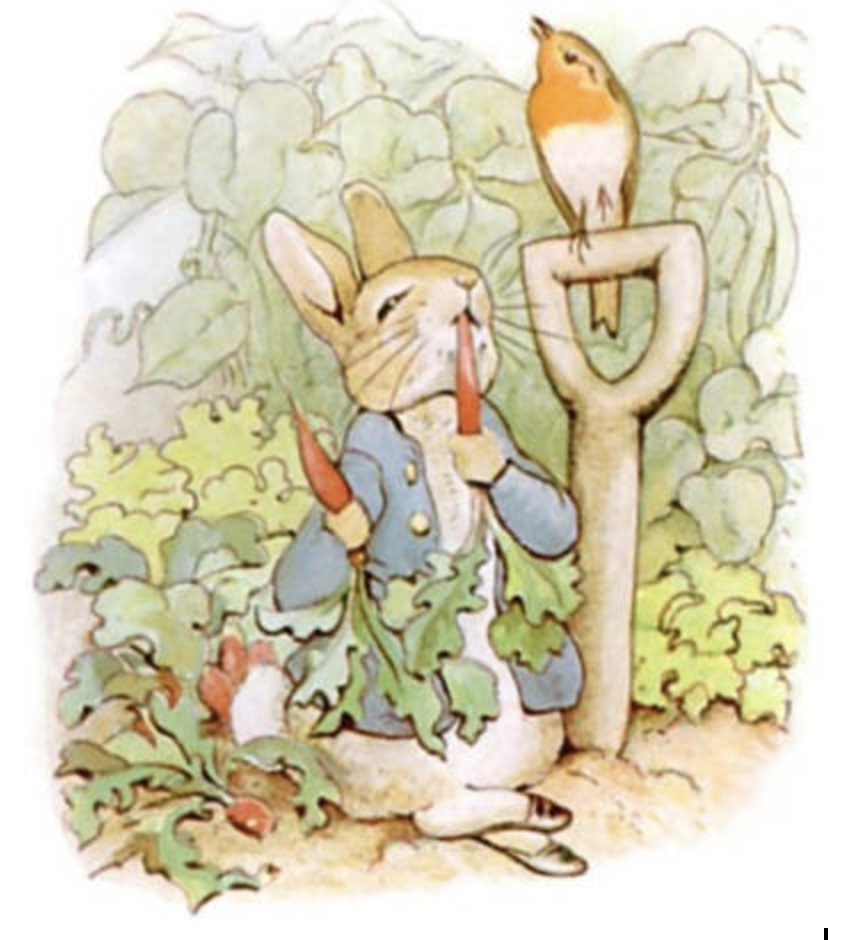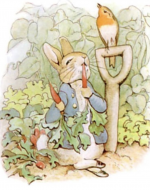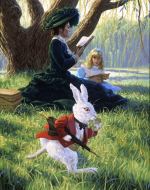Created by Annabelle Aber on Wed, 03/03/2021 - 19:21
Description:
Animals commonly appear in entertaining and didactic texts alike. Although many of these stories focus on anthropomorphic creatures as the main characters, there are also often smaller, less noticeable animals appearing in the backgrounds of illustrations or as secondary characters. As children’s literature shifted from being didactic to entertaining, a change also appeared in the purpose of these smaller figures, sometimes not mentioned in the text at all. In entertaining texts that include lessons, such as Beatrix Potter’s Peter Rabbit (1902), secondary animals often signify a guardian figure watching over the main character, either with disapproval or support. This sends messages to children that they should always be aware of their behaviors. However, in more lighthearted, entertaining texts such as Lewis Carroll’s Alice in Wonderland (1865), animals can act as a friend or mentor to the main character. Overall, it is important to notice these animals in book illustrations that deepen and add a layer of sophistication to landmark children's books.
Beatrix Potter, "Peter Overeating Radishes," from Peter Rabbit (1902), by Beatrix Potter. Internet Archive and Project Gutenberg version.
In Peter Rabbit, Peter is followed by a small robin as he disobeys his mother’s instructions and explores Mr. McGregor’s garden. The robin shown in this first plate appears 6 times throughout the book, a repetition which makes the bird a motif. It can be inferred that the robin represents Peter's father, who was killed in that same garden. Peter's mother tells him not to go into the garden, so the bird is watching over Peter with a fatherly disapproval, emphasizing lessons of obedience and proper behavior. The presence of this robin, never mentioned in the book, is subtle yet significant. Peter believes that he escapes from his mother’s watchful eye, but he is truly never void of observation and is constantly subject to parental influence. This is a playful tale about a naughty rabbit who has an adventure, but the robin is a reminder to discerning readers that children were expected to be obedient and well behaved at all times.
Greg Hildebrandt, "Alice Sees the White Rabbit," from Alice in Wonderland (1865), by Lewis Carroll, 1990 version. Spiderwebart.
Alice in Wonderland is an entertaining book for children that also incorporates parody of the Victorians. Carroll uses many secondary characters to represent his parodic approach and to entertain his readers. The White Rabbit can be seen as a facilitator of Alice’s adventures. He leads her into Wonderland and develops somewhat of a friendship with Alice throughout the tale. In this 1990 image (plate 2), illustrator Greg Hildebrandt captures Alice's entrance into the enchanting world of Wonderland. Reading her book, she notices a rabbit running by and holding a pocketwatch. This image anticipates how she will soon run after the rabbit and fall down the rabbit hole into Wonderland. The White Rabbit introduces her to a world of adventure and accompanies her on her journey.
John Tenniel, "The White Rabbit, Esq.," from Alice's Adventures in Wonderland (1865), by Lewis Carroll, Wikipedia.
The White Rabbit, who makes many appearances in Alice in Wonderland, also caricatures Victorian era values. More than Hildebrandt, Tenniel (plate 3) shows how the White Rabbit has many features and qualities that are reminiscent of a Victorian gentleman, but at the same time catalyzes many of Alice’s opportunities of adventure. The rabbit’s Victorianesque features include his propensity for punctuality, aided by his pocketwatch and constant awareness of time. This can be seen as a reference to industrialization in the Victorian era during which clocks and watches became increasingly more common and resulted in a heightened focus on time. In this way, Carroll and Tenniel use Alice's friend the White Rabbit to parody Victorianism by mocking its values.
Robert Lawson, "There Was a Little Bull, and His Name Was Ferdinand," from The Story of Ferdinand (1936), by Munro Leaf.
The picture book The Story of Ferdinand by Munro Leaf represents a very important bridge between the era of didacticism and its rejection. Ferdinand the bull is portrayed as a gentle soul who wishes for peace and strays from the bull fighting that he is destined for. As in this plate by Robert Lawson (plate 4), Ferdinand is often seen sniffing flowers and strolling fields accompanied by butterflies. These small characters, not mentioned as in the case of Potter's robin, become a motif for the story and offer another example of subtle appearances of animals with big meaning. Seeing Ferdinand frolic among butterflies angered some readers, who claimed that Ferdinand’s behaviors were emasculating; flowers and butterflies, coupled by his refusal to fight, were testiments to Leaf's support of pacifism. Messages that supported pacifism and opposed war were widely regarded as propaganda and led to the book's eventual banning in many countries. In today’s world, children can recognize that the butterflies who follow the main character are watching over Ferdinand, supporting his differences.
Copyright:
Associated Place(s)
Part of Group:
Featured in Exhibit:
Artist:
- Beatrix Potter





